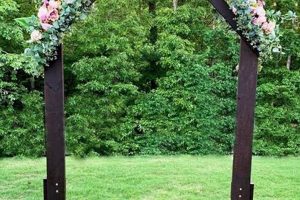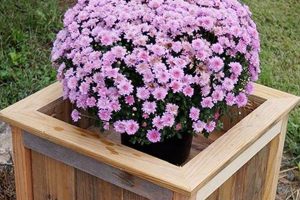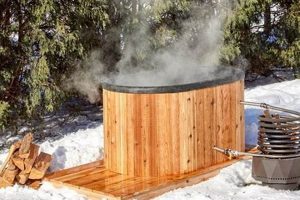The creation of shelving units from timber through a do-it-yourself approach involves selecting appropriate wood, cutting it to the desired dimensions, and assembling the components to form a functional storage structure. This process empowers individuals to customize shelving to meet specific needs and aesthetic preferences. For example, a homeowner might construct floating shelves from reclaimed lumber to display decorative items in a living room.
This method of furniture construction offers numerous advantages, including cost savings, personalized design, and the satisfaction of creating a useful item. Historically, self-sufficiency in crafting household items, including storage solutions, was commonplace. The modern resurgence of this activity reflects a desire for unique, handcrafted pieces and a more hands-on approach to home improvement.
Understanding material selection, joinery techniques, and finishing options are key to achieving durable and visually appealing results. The subsequent sections will delve into the specific aspects of planning, building, and finishing these projects, providing the information necessary for successful completion.
Essential Considerations for Timber Shelving Projects
Achieving a successful outcome in woodworking projects requires careful planning and execution. These guidelines address crucial aspects to ensure structural integrity and aesthetic appeal.
Tip 1: Wood Selection is Paramount: Prioritize hardwood species like oak, maple, or cherry for strength and durability when constructing shelving intended to bear significant weight. Softwoods, such as pine, are suitable for lighter loads but necessitate greater care during assembly to prevent splitting.
Tip 2: Precise Measurements are Critical: Accurately measure the available space and the intended contents of the shelves. Implement a cut list detailing all required dimensions to minimize material waste and ensure proper fit during assembly.
Tip 3: Employ Robust Joinery Techniques: Select appropriate joinery methods based on the intended load and aesthetic preferences. Options include dadoes, rabbets, mortise and tenon joints, or pocket hole screws. Ensure that each joint is square and securely fastened.
Tip 4: Surface Preparation Enhances Finish: Thoroughly sand all wood surfaces, progressing from coarser grits to finer grits. Proper sanding creates a smooth surface that enhances the adhesion and appearance of the chosen finish.
Tip 5: Finishing Protects the Wood: Apply a protective finish, such as varnish, lacquer, or polyurethane, to seal the wood and protect it from moisture, scratches, and UV damage. Multiple coats are recommended, with light sanding between coats for a flawless appearance.
Tip 6: Use the right equipment: Having the right tools is key to get the job done correctly. Table saw, Sander and power drill are important tools to have.
Tip 7: Inspect the material: When buying the raw material make sure its not broken, too bent or other flaw.
Adhering to these principles will contribute to the creation of sturdy, visually appealing storage solutions that enhance the functionality and aesthetics of any space.
The subsequent section will explore advanced techniques and project ideas, offering further guidance for individuals seeking to expand their woodworking skills.
1. Material Selection
Material selection is a foundational element in the creation of timber shelving units. The type of wood chosen directly impacts the structural integrity, aesthetic appeal, and longevity of the finished product. Therefore, careful consideration of wood properties is crucial before commencing any do-it-yourself shelving project.
- Hardwood vs. Softwood: Structural Implications
Hardwoods, such as oak, maple, and cherry, offer superior strength and resistance to wear, making them ideal for shelving intended to support heavy loads. Their dense structure resists warping and denting. Conversely, softwoods, like pine and fir, are less expensive and easier to work with, but their lower density makes them more susceptible to damage and unsuitable for significant weight. The intended use of the shelves dictates the appropriate wood type.
- Grain Pattern and Aesthetic Considerations
The grain pattern of wood significantly influences the visual appearance of the finished shelves. Some species, like walnut, exhibit rich, intricate grain patterns that enhance the aesthetic value of the project. Others, like poplar, have a more uniform and subdued grain. The choice depends on the desired aesthetic outcome and whether the shelves will be stained or painted. Considerations should include matching the grain to existing furniture or achieving a specific design style.
- Moisture Content and Stability
Wood is hygroscopic, meaning it absorbs and releases moisture from the surrounding environment. The moisture content of the wood at the time of construction impacts its stability. Wood that is too wet will shrink and warp as it dries, compromising the structural integrity of the shelves. Kiln-dried lumber with a stable moisture content is essential for minimizing these issues. Acclimatizing the wood to the environment where the shelves will be installed further enhances stability.
- Cost and Availability
The cost of different wood species varies significantly depending on availability and demand. Rare or exotic hardwoods can be expensive, while more common softwoods are generally more affordable. Consider the budget constraints of the project and the availability of specific wood types in the local market. Balancing cost with the desired properties and aesthetic qualities is a key aspect of material selection.
In summary, material selection is an integral aspect of achieving successful shelving projects. Informed choices, considering structural needs, aesthetic preferences, moisture stability, and budgetary constraints, are vital in realizing both functional and visually pleasing solutions.
2. Accurate Measurements
Precise dimensional assessment forms the bedrock of successful timber shelving construction. Deviations from planned measurements propagate errors throughout the project, potentially compromising structural integrity and aesthetic harmony. Inaccurate dimensions during the initial cutting phase cascade into misaligned joinery, uneven shelf surfaces, and ultimately, a compromised final product. For instance, a shelf intended to fit snugly within a 36-inch alcove, if cut to 36.25 inches, will not fit, requiring rework and wasted materials. The practical significance lies in minimizing material waste, reducing project time, and ensuring a professional-looking outcome.
Further exemplifying the connection, consider the placement of shelf supports or brackets. Miscalculated distances between supports lead to uneven weight distribution, potentially causing shelves to sag or fail under load. If vertical supports are not perfectly perpendicular due to measurement errors, the entire shelving unit risks instability. In more complex shelving systems involving multiple tiers or interlocking components, the cumulative effect of even minor inaccuracies amplifies, rendering assembly difficult or impossible. Accurate measurements, therefore, are not merely a preliminary step, but a continuous reference point throughout the entire construction process.
In summation, accurate dimensional assessment is not just a component of timber shelving projects; it is a critical determinant of project success. Errors in measurement introduce a ripple effect of complications, from material wastage to structural instability. Overcoming these challenges requires meticulous planning, the use of reliable measuring tools, and a commitment to verifying dimensions at each stage of the construction process. This focus ensures both a functional and visually satisfactory final product, ultimately validating the time and effort invested.
3. Secure Joinery
The structural integrity and longevity of any wooden shelving system are inextricably linked to the quality and appropriateness of its joinery. Securely joined components resist deformation under load, withstand the stresses of daily use, and maintain the visual appeal of the finished piece over time. Neglecting proper joinery techniques can result in wobbly shelves, splitting wood, and ultimately, the collapse of the entire structure.
- Mechanical Fasteners: Screws and Bolts
Screws and bolts provide mechanical clamping force, holding wooden components together. The appropriate choice depends on the wood density and the anticipated load. Pilot holes are crucial to prevent splitting, especially when working with hardwoods. For heavier loads, bolts offer superior strength compared to screws, but require more precise drilling and fitting. Proper countersinking ensures that fastener heads are flush with the surface, enhancing both aesthetic and safety.
- Adhesive Bonding: Glues and Epoxies
Wood glues, such as polyvinyl acetate (PVA) glue, create strong bonds between wood surfaces. Proper surface preparation, including cleaning and clamping, is essential for optimal adhesion. Epoxies offer superior strength and gap-filling capabilities, making them suitable for more demanding applications or situations where precise fit is difficult to achieve. However, epoxies typically require longer curing times and may be more expensive than PVA glues. The selection of adhesive must be compatible with the wood species and the intended use of the shelves.
- Traditional Joinery: Mortise and Tenon, Dovetails
Traditional joinery techniques, such as mortise and tenon or dovetail joints, create interlocking connections that resist pulling forces. These methods require precision cutting and fitting, but offer exceptional strength and aesthetic appeal. Mortise and tenon joints involve inserting a projecting tenon into a corresponding mortise, while dovetails feature interlocking wedge-shaped projections. These techniques are particularly well-suited for high-end shelving projects where durability and craftsmanship are paramount.
- Reinforcement Techniques: Dowels and Biscuits
Dowels and biscuits serve as reinforcement elements within joints, increasing surface area and enhancing mechanical strength. Dowels are cylindrical rods inserted into pre-drilled holes, while biscuits are oval-shaped wafers inserted into slots cut with a biscuit joiner. These techniques are often used in conjunction with adhesives to create stronger and more stable joints. Dowels and biscuits are particularly useful for aligning and reinforcing edge-to-edge joints, such as those used in shelf construction.
In conclusion, selecting the appropriate joinery method is paramount for the successful creation of durable and visually appealing timber shelving units. Whether employing mechanical fasteners, adhesive bonding, traditional joinery, or reinforcement techniques, each approach offers distinct advantages and limitations. The ultimate choice should be guided by the specific requirements of the project, including the anticipated load, the desired aesthetic, and the available skill level of the builder. A thorough understanding of joinery principles ensures a finished product that is both functional and aesthetically pleasing.
4. Surface Preparation
Surface preparation forms a critical and indispensable stage in the construction of wooden shelving through do-it-yourself methods. Its impact directly influences the quality of the finish, the longevity of the shelf, and its overall aesthetic appeal. Improper surface preparation invariably leads to defects in the final product. For example, a failure to thoroughly sand a wooden board prior to staining results in uneven stain absorption, highlighting imperfections and creating a blotchy, unprofessional appearance. Similarly, the presence of dust, grease, or other contaminants prevents proper adhesion of paints, varnishes, or other protective coatings, leading to chipping, peeling, and premature degradation of the finish. Therefore, surface preparation is not merely a cosmetic step but a fundamental component that determines the shelf’s resistance to environmental factors and daily wear.
The process of surface preparation encompasses several key stages, each contributing uniquely to the final outcome. Initial cleaning removes surface contaminants, followed by sanding to smooth the wood and create a uniform texture. Filling any cracks, knots, or imperfections with wood filler ensures a level surface for finishing. Finally, a pre-stain conditioner can be applied to certain woods to promote even stain absorption and prevent blotching. An illustration of the practical significance is seen in the restoration of reclaimed lumber. Reclaimed wood often possesses a rough texture and may contain remnants of old finishes or adhesives. Effective surface preparation, involving thorough cleaning, sanding, and filling, transforms this weathered material into a suitable surface for constructing aesthetically pleasing and structurally sound shelves. This step directly affects the final aesthetic, transforming rough-hewn lumber into usable shelving.
In summary, surface preparation is an essential precursor to any successful wooden shelving project. It is intrinsically linked to the durability, appearance, and overall value of the finished product. The consequences of neglecting this stage range from cosmetic imperfections to compromised structural integrity. Prioritizing thorough and meticulous surface preparation ensures a professional-quality result, enhancing the functionality and visual appeal of the shelves. Achieving a smooth surface, free of imperfections, is a vital investment in the project’s long-term viability and aesthetic success.
5. Protective Finishing
Protective finishing is a critical phase in timber shelving projects, directly impacting the longevity, aesthetic appeal, and functionality of the finished product. The selection and application of suitable finishes safeguard the wood from environmental factors, daily wear, and potential damage. This stage extends beyond mere aesthetics, functioning as a preventative measure against deterioration and ensuring the sustained quality of the shelving.
- Moisture Resistance
Wood is susceptible to moisture absorption, leading to warping, swelling, and the potential for mold or mildew growth. Protective finishes, such as varnishes and polyurethanes, create a barrier that repels water and reduces moisture penetration. This is particularly vital in environments with high humidity or where shelves are exposed to occasional spills. Failure to adequately seal the wood can result in irreversible damage, compromising the structural integrity of the shelving.
- Scratch and Abrasion Resistance
Shelves are frequently subjected to the abrasion of items being placed upon and removed from them. Finishes with high scratch resistance, such as catalyzed lacquers or durable polyurethanes, protect the wood surface from scratches, scuffs, and other forms of physical wear. This is especially important for shelves used to store heavy or abrasive objects, preserving their appearance over extended periods. The selection of a finish that withstands everyday use is essential for maintaining the shelving’s aesthetic quality.
- UV Protection
Exposure to ultraviolet (UV) radiation can cause fading, discoloration, and degradation of wood surfaces. Finishes containing UV inhibitors, such as certain exterior-grade varnishes, mitigate the harmful effects of sunlight. This is particularly relevant for shelving placed near windows or in areas with direct sun exposure. Without UV protection, the wood’s natural color can be altered, and the finish itself may become brittle and prone to cracking. Preserving the wood’s original tone and the finish’s integrity necessitates employing UV-resistant coatings.
- Enhancing Aesthetic Appeal
Beyond protection, finishes enhance the visual characteristics of the wood. Stains can be used to alter the color, highlighting the wood grain or matching existing dcor. Clear finishes, such as lacquer or shellac, preserve the wood’s natural beauty while providing a protective layer. The choice of finish allows customization of the shelving’s aesthetic, enabling a seamless integration with the surrounding environment. The final aesthetic results from a combination of the finish’s protective characteristics and its ability to bring out the wood’s intrinsic beauty.
The implementation of appropriate finishing techniques constitutes an integral aspect of crafting durable, attractive, and functional shelving units. The selection and application of finishes is not merely a cosmetic consideration; it is a practical investment in the longevity and performance of the shelving, safeguarding against environmental factors, mechanical damage, and aesthetic degradation. This ensures that crafted shelving units not only fulfill their intended purpose but also retain their visual appeal for years to come.
Frequently Asked Questions
This section addresses common inquiries regarding the creation of shelving units from timber through do-it-yourself methods. The following questions and answers provide clarification on critical aspects of design, construction, and maintenance.
Question 1: What wood species are most suitable for heavy-duty shelving?
Hardwood species, such as oak, maple, and walnut, offer superior strength and density, making them ideal for shelving intended to support significant weight. These woods exhibit greater resistance to bending, warping, and denting compared to softwoods.
Question 2: How can splitting of wood be prevented when driving screws?
Drilling pilot holes that are slightly smaller than the screw’s core diameter is essential for preventing wood splitting. This practice reduces stress on the wood fibers as the screw is driven. Furthermore, using screws specifically designed for wood, featuring a self-tapping design, can minimize the risk of splitting.
Question 3: What is the recommended method for achieving a level shelf surface?
Employing a spirit level or laser level is crucial for ensuring a level shelf surface. These tools provide a visual reference for accurately aligning shelf supports or brackets. Adjustments can be made by shimming the supports until a level reading is obtained.
Question 4: How can the appearance of knots in wood be minimized?
Knots are a natural characteristic of wood, but their appearance can be minimized through several methods. Filling the knots with wood filler or epoxy resin creates a smooth, uniform surface. Alternatively, incorporating knots into the design aesthetic can enhance the rustic or natural appearance of the shelves.
Question 5: What are the best practices for maintaining finished wooden shelves?
Regular dusting and cleaning with a soft, damp cloth are essential for maintaining finished wooden shelves. Avoid using abrasive cleaners or solvents, which can damage the finish. Applying a furniture polish or wax periodically can help protect the finish and enhance its luster.
Question 6: How can sag be prevented in long shelving spans?
Sagging in long shelving spans can be prevented by increasing the thickness of the shelf material or reducing the distance between supports. Employing a strong, rigid material, such as plywood or hardwood, is recommended. Adding a vertical support in the middle of the span provides additional reinforcement and prevents sagging under load.
The information presented addresses common concerns and best practices for DIY timber shelving construction. Adhering to these guidelines contributes to the creation of durable, functional, and aesthetically pleasing storage solutions.
The subsequent section will provide an in-depth guide into Wood Shelves DIY project, from start to finish.
Conclusion
This exploration has detailed the fundamental aspects of constructing shelving units from timber, emphasizing the crucial roles of material selection, accurate measurement, secure joinery, surface preparation, and protective finishing. Each phase contributes directly to the structural integrity, aesthetic quality, and long-term durability of the finished product. A deficiency in any of these areas can compromise the overall outcome.
The information presented serves as a foundational resource for individuals undertaking such projects. Diligent application of these principles is essential for realizing functional and visually appealing storage solutions. The successful implementation of these techniques not only provides practical shelving but also fosters a deeper understanding of woodworking principles, thereby promoting a commitment to quality craftsmanship and self-sufficiency.







![[DIY Guide] Easy DIY Wood Window Shutters You Can Build! The DIY Hub: Creative Crafts, Repairs & Life Hacks [DIY Guide] Easy DIY Wood Window Shutters You Can Build! | The DIY Hub: Creative Crafts, Repairs & Life Hacks](https://craftingdiycenter.com/wp-content/uploads/2025/07/th-3579-300x200.jpg)